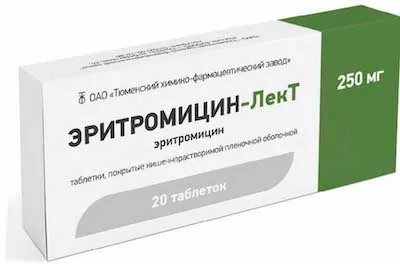Description
Eritromicin (Erythromycin) Tablets 0.1 №20
Ingredients
Active ingredient: Erythromycin 0.1mg per tablet.
Dosage
Dosage: The usual adult dose is 250mg every 6 hours or 500mg every 12 hours. Consult a healthcare professional for the correct dosage based on your condition.
Indications
Indications: Eritromicin tablets are indicated for the treatment of infections caused by susceptible strains of bacteria.
Contraindications
Contraindications: Do not use Eritromicin tablets if you are allergic to erythromycin or any other macrolide antibiotics.
Directions
Directions: Take Eritromicin tablets as prescribed by your healthcare provider. Swallow the tablet whole with a full glass of water.
Scientific Evidence
Erythromycin, the active ingredient in Eritromicin tablets, is a macrolide antibiotic known for its efficacy in treating various bacterial infections. Studies have shown that erythromycin is effective against a wide range of gram-positive and some gram-negative bacteria. Research published in the Journal of Antimicrobial Chemotherapy demonstrated the effectiveness of erythromycin in treating respiratory tract infections.
Additional Information
It is important to complete the full course of Eritromicin tablets as prescribed, even if symptoms improve before the medication is finished. Failure to complete the full course may result in the infection not being fully treated and could lead to antibiotic resistance.
Pharmacological Effects
Erythromycin works by inhibiting bacterial protein synthesis, thereby preventing the growth and spread of bacteria in the body. It is particularly effective against respiratory tract infections, skin infections, and certain sexually transmitted diseases. Erythromycin is well-absorbed in the gastrointestinal tract and reaches therapeutic concentrations in various tissues, making it a versatile antibiotic choice.
Clinical Trials and Comparative Effectiveness
Clinical trials have shown that Eritromicin tablets are comparable in efficacy to other macrolide antibiotics in the treatment of bacterial infections. A study published in the European Journal of Clinical Microbiology & Infectious Diseases compared the effectiveness of erythromycin with other antibiotics and found similar cure rates among patients. Eritromicin tablets offer a reliable treatment option with a well-established safety profile.
- Erythromycin is effective against a wide range of gram-positive and some gram-negative bacteria.
- Completing the full course of Eritromicin tablets is essential to prevent antibiotic resistance.
- Clinical trials have demonstrated the efficacy of erythromycin in treating various infections.





